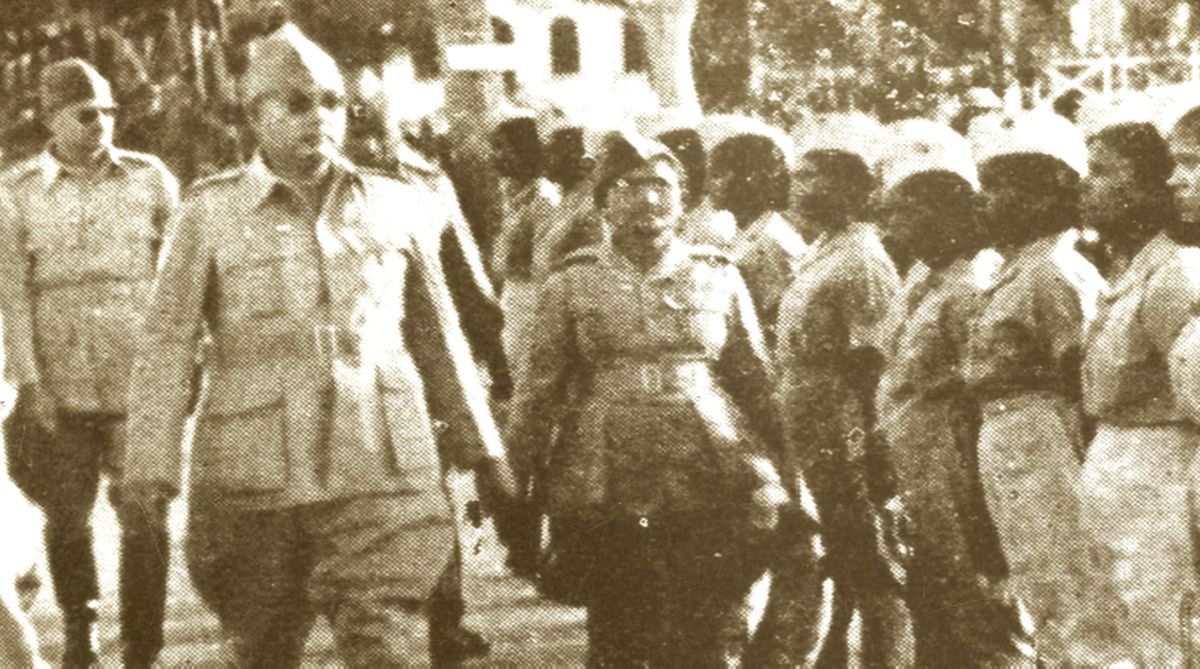Armed with money, Bose began mobilising forces for the INA with an immediate target of 50,000 soldiers. Most of them would be enlisted from the ranks of POWs of the British Army and supplemented by civilian volunteers. In a revolutionary step Netaji set up a regiment of women. This was appropriately named as the Rani of Jhansi regiment after the revolutionary leader of 1857 war of independence. Lakshmi Swaminathan, a successful gynaecologist from Singapore was enlisted as the Chief of the Regiment.
He procured weapons and ammunition from the Japanese. As per Netaji’s request the Andaman and Nicobar Islands, that had been captured by the Japanese in 1942, were placed under the administrative jurisdiction of the Azad Hind Government. The islands were named by Netaji as Swaraj and Saheed. He shifted the headquarters of the Azad Hind Government to Rangoon which had fallen to the Japanese so that the INA could mount an attack on the Indian mainland. In 1944 the combined campaign of the Japanese and INA took the British by surprise. Kohima was captured early on 6 April 1944. They also set foot on Manipur.
Advertisement
But the tide began to turn against INA and the Japanese. Considerable air power of the British stopped the advance of the Japanese and the INA. After three months of siege in Imphal and Kohima, the Japanese and the INA had to retreat. The British army advanced into Burma and the Japanese began to leave. Bose was forced to quit. He left Rangoon on 24 April 1945 and reached Bangkok almost on foot on 14 May. From there he flew to Singapore. In midAugust he left for Saigon on what has been regarded as his last journey.
Netaji, according to the Japanese account and that of Col. Habibul Rehman, the deputy chief of the INA, died of the injuries received in the air crash at Taipeh (Taihoku) airport on 18 August 1945. Several analysts and observers of contemporary events are of the opinion that the tale of the air crash and subsequent death was a piece of downright falsehood and the air crash never took place.
After declassification of a number of files in 2015 relating to Netaji that were in the custody of the West Bengal State Intelligence Department, it transpired that Netaji lived beyond 1945. The Government of India tried to convince the people at large that Bose had perished in the air crash at Taihoku. The Shah Nawaz Khan Commission was entrusted to look into the matter.
Shaw Nawaz was made a minister of the Central Government. Safely ensconced in a coveted position at the instance of Nehru, he did what was expected of him and served the benefactor faithfully. Many important functionaries resorted to sordid lies in their evidence before the Khosla Commission which was set up in 1970. But in the report submitted by the last committee of Inquiry i.e. Mukherjee Commission in 2005, Justice Mukherjee categorically stated that Netaji could not have died in the air crash on that fateful day as there was no evidence of such a crash.
The Government of India under the stewardship of Nehru stalled all efforts to ascertain the truth. During World War II, a large part of the Soviet administration had moved to Omsk in Siberia to be far away from Germans. And it is to Omsk that Netaji sought to travel once it seemed that the end of war was imminent as per the version of a number of journalists and knowledgeable persons.
In a frantic attempt to prove Netaji’s death in the so-called air crash, Nehru had proceeded to a ridiculous length. According to the account of Chitra Bose, daughter of Sarat Bose, he brought a charred wrist watch and carried it to the house of Sarat Bose to show the sure sign of Netaji’s death. Sarat Bose emphatically stated ‘Jawahar, this is not the wristwatch of Subhas who wore a round-shaped one gifted to him by mother.’ Another act of nervous tension was when he abruptly pulled down the sari of Vijaylakshmi Pandit and made her sit down when she was about to blurt out enthusiastically about her revelation relating to Netaji in Moscow where she was sent as an ambassador. Radhakrishnan reportedly saw Subhas but nothing was heard from him thereafter. He was very loyal to Nehru and a great scholar and eventually became the President of India.
After Glasnost and Perestroika in Russia, a number of secret files in the Archives of the KGB relating to Netaji were declassified. It has been gleaned from relevant records of the Government of India that a Joint Secretary to the Government proposed to send a demarche (a very strong request for a certain information) to the Soviet Union to provide information about Netaji from the KGB Archives. The then Finance Minister who subsequently rose higher called an urgent meeting and the matter was closed.
The Government of India never requested the Allies after the war to remove the name of Netaji from the list of war criminals. Nobody lobbied effectively for Netaji’s freedom after independence. The Communist Party of India was on the rise with their special link with the Soviet Union. And the Communists did not evince any interest in the matter. In fact, Netaji was too precious a gem to be appreciated by the crass materialists. Significantly, when news broke about the air crash, Mahatma Gandhi had sent a telegram to Sarat Bose not to perform sradh. The Mahatma went so far as to say abruptly, Dusra kissika laash jala dia hoga. This is a gruesome indication of the matter in question.
Such is Netaji’s life ~ a painful saga of sacrifice, suffering and incarceration. Now a question was raised by a section of political observers. Did Netaji survive in Stalin’s gulag, one of the most hideous concentration camps in Siberia or does he lie buried under the ‘Road of Bones’. It is stated in Alexander Solzhenitsyn’s Gulag Archipelago that prisoners who died while working were buried under the roads that were then being built in the Kolyma Highway in Siberia leading to Moscow. This road gained notoriety as Siberia’s ‘Road of Bones’ as mentioned by Solzhenitsyn who spent eleven years as a prisoner in the Gulag. An answer to this was that Netaji was ultimately freed, badly battered and bruised, decrepit and worn out, when conditions there after Stalin’s death were propitious.
Some optimists believe, not without reason, that Netaji was out of the prison by miraculous effort, trod amid the tempestuous conglomeration of humanity, undetected and unrecognised and plodded the weary way to the heart of his ‘divine motherland’. But the final answer must be sought in the domain of divinity. Those dearest to God smart under stinging pain and suffering, burn with searing agony till they become luminous with purity and transcend the shackles of psychosis and eventually merge with the supreme. Sa Yogi Moyee Bartate.
(Concluded)
The Weiter is a retired IAS officer.











